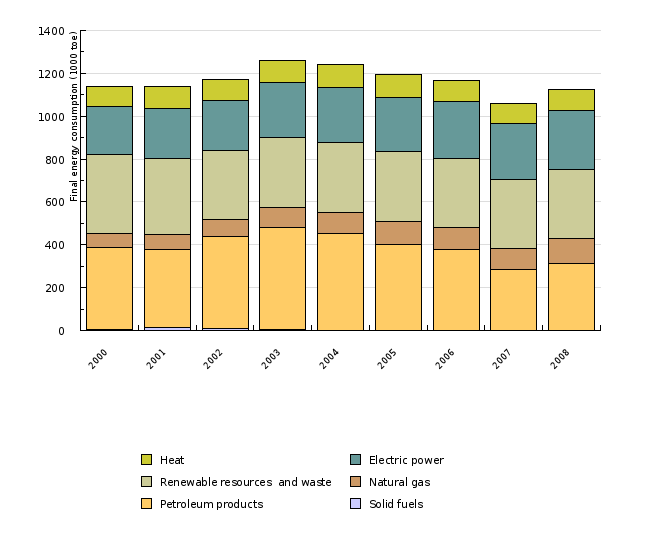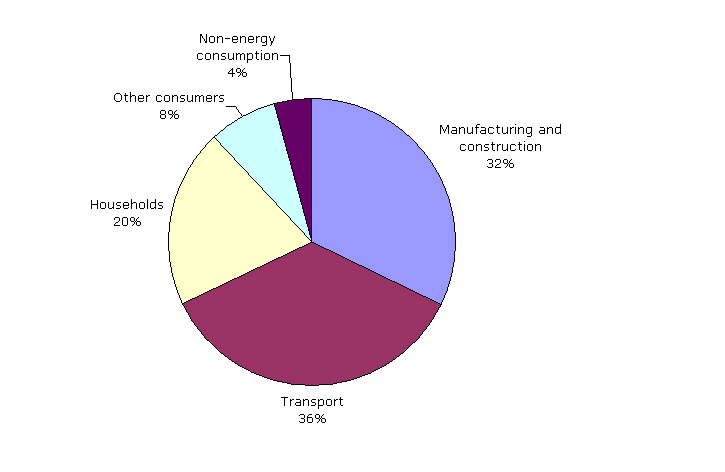[PG04] Household energy and transportation fuel consumption

Key message

Slovenian households consume around 20 percent of final energy. Consumption has decreased since 2003, mainly on account of petroleum products, consumption of which fell in 2007 by 40% compared to 2003. Most energy is consumed for space heating, amounting to 53% in 2002. In the same year, 25% of energy was spent for cooking and 13% for heating water.
Definition
The indicator shows the development of the final energy consumption in households and the structure of consumed energy with regard to the energy source or fuel and the type of use.
Charts
Statistical Office of the Republic of Slovenia, SI-STAT Data Portal, 2009
| 2000 | 2001 | 2002 | 2003 | 2004 | 2005 | 2006 | 2007 | 2008 | ||
|---|---|---|---|---|---|---|---|---|---|---|
| Solid fuels | (1000 toe) | 5 | 13 | 8 | 4 | 0 | 0 | 0 | 0 | 0 |
| Petroleum products | (1000 toe) | 382 | 364 | 433 | 476 | 451 | 401 | 377 | 286 | 315 |
| Natural gas | (1000 toe) | 65 | 69 | 76 | 96 | 101 | 109 | 104 | 95 | 114 |
| Renewable resources and waste | (1000 toe) | 370 | 358 | 324 | 324 | 324 | 324 | 324 | 324 | 324 |
| Electric power | (1000 toe) | 224 | 230 | 233 | 259 | 259 | 254 | 263 | 260 | 274 |
| Heat | (1000 toe) | 94 | 104 | 97 | 100 | 107 | 109 | 100 | 93 | 100 |
| Energy resources | (1000 toe) | 1139 | 1137 | 1171 | 1259 | 1242 | 1197 | 1167 | 1058 | 1126 |
Statistical Office of the Republic of Slovenia, SI-STAT Data Portal, 2009.
| Space heating | Water heating | Cooking | Other | ||
|---|---|---|---|---|---|
| Energy source 2002 | TJ | 27429 | 6720 | 13175 | 4570 |
| Share | % | 53 | 13 | 25 | 9 |
Statistical Office of the Republic of Slovenia, SI-STAT Data Portal, 2009.
| Energy sector | Manufacturing and construction | Transport | Households | Other consumers | Non-energy consumption | ||
|---|---|---|---|---|---|---|---|
| 2007 | (1000 toe) | 20 | 1665 | 1834 | 1058 | 397 | 217 |
| 2007 | % | 0 | 32 | 35 | 21 | 8 | 4 |
Goals
Final energy savings in the period 2008 - 2016 by 9 percent or 4,261 GWh by implementing the planned instruments within the framework of the NEEAP. The household sector measures represent 1,165 GWh (27%).
Objectives at the EU level by 2020:
- a 20% reduction in energy use;
- a 20% reduction of greenhouse gas emissions;
- 20% of the energy consumed by the EU must be obtained from renewable energy sources.
Comment
Slovenian households consume around 20% of final energy, including the processing activities and construction, just over a half.
Final energy consumption in households has been decreasing since 2003, mainly on account of petroleum products, consumption of which fell by 40% in 2007 compared to 2003, when consumption was the highest. Reduced use of light fuel oil in 2007 was most likely a consequence of the growing prices and consequently postponed purchase of fuel. After 2003, consumption of other types of energy has been more or less the same. In this period, some fluctuations were noted only with regard to natural gas and heat. In 2007, a million toe (ton of oil equivalent) of energy from various energy sources were consumed for the supply of households, 31% of which were from renewable sources (including hydroelectric power plants) and waste, 27% from petroleum products, 25% from electric energy, and 9% from natural gas and heat with the same share.
According to the latest data available (SORS 2002), Slovenian households consume most of the final energy for space heating (53%), cooking (25%), and water heating (13%).
The National Energy Efficiency Action Plan for the period 2008-2016 describes the set of instruments that will improve energy efficiency in households, mainly in heating and final energy consumption. However, their implementation depends on the provision of funds and the information provided to the consumers about the possibilities and benefits of efficient energy use. The package of fiscal incentives includes four programmes: for energy-efficient renovation of buildings and sustainable construction of buildings, energy-efficient heating systems, efficient use of electric energy, and the energy efficiency scheme for low-income households.
In EU-25 households (EEA Report 2008) most energy is consumed for space heating (70%, water heating (14%), and electrical appliances and lighting (12%). In most of the EU-15 Member States, the general efficiency of space heating in households has increased in the last 15 years, mainly due to improved insulation and prevention of heat loss. However, these improvements have been more than nullified by the growth in the number and size of dwellings and increased average temperatures.
Electric appliances and lighting also provide possibilities for improving energy efficiency. Some light bulbs consume from 30% to as much as 80% less energy than they used to.
Methodology
Data for Slovenia:
Objectives summarized by:
- The National Energy Efficiency Action Plan for the period 2008-2016. The objectives are in line with Article 4 of Directive 2006/32/E:, to achieve 9 percent final energy savings by implementing the planned instruments comprising the measures for the efficient use of energy and energy services, and are in compliance with the starting-points of the Resolution on the National Energy Programme and Directive 2006/32/EC.
- EU Action Plan for Energy Efficiency.
Source database or source: Statistical Office of the Republic of Slovenia, SI-STAT Database (Energy balance (1000 toe), November 2007; Final energy consumption in households by energy source; Energy Balance (1000 toe), July 2009).
Data administrator: Statistical Office of the Republic of Slovenia
Data acquisition date for this indicator: 15 August 2009
Methodology and frequency of data collection for the indicator: Annual data collection on energy balance and a 5-year data collection on final consumption of energy and fuels in households by energy sources.
The data on the quantity and structure of final energy consumption in households by energy sources is derived from the SI-STAT Data Portal of the Statistical Office of the Republic of Slovenia, November 2007, the Energy Balance Dataset (1000 toe), Slovenia, annually.
The data on the structure of final energy consumption in households is derived from the SI-STAT Data Portal of the Statistical Office of the Republic of Slovenia, July 2009, the Final Energy Consumption in Households by Energy Source Dataset, Slovenia, a 5-year collection.
The data on the share of energy consumption in households is derived from the SI-STAT Data Portal of the Statistical Office of the Republic of Slovenia, July 2009, the Energy Balance Dataset (1000 toe), Slovenia, annually.
Data processing methodology: /
Information concerning data quality:
- advantages and disadvantages of the indicator:
- relevance, accuracy, robustness, uncertainty:
Reliability of the indicator (archival data): /
Uncertainty of the indicator (scenarios/projections): /
- Overall assessment (1 = no major comments, 3 = data to be considered with reservation): 2
Relevance: 2
Accuracy: 1v
Completeness over time: 2
Completeness over space: 1
Other sources and literature:
Comparison for Europe and the wider area is derived from:
• EEA, 2006: Europe's Environment, The fourth assessment
• EEA Technical report; No. 1/2008; Time for action – towards sustainable consumption and production in Europe, Summary report of the conference held on 27 – 29 September 2007, Ljubljana, Slovenia











